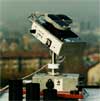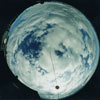
| An opto-electronic model of a polarization-sensitive neuron | ||||||
We have constructed a field-proof opto-electronic model of a polarization-sensitive neuron (POL-neuron) that implements the basic physiological properties of cricket POL1-neurons in the optic lobe as previously measured by electrophysiological experiments. Thus, the model neuron exhibits polarization-opponency (see Fig. 3), has a large visual field of 60° diameter, which is directed to the upper part of the sky, and is maximally sensitive in the blue range (see Fig. 1). Thus, with this model neuron, the polarization pattern of the sky can be viewed as seen through an insect eye. |
|
|||||
We exposed the model neuron to the natural skylight under a variety of meteorological conditions (see Fig. 2) and assessed both the strength of the polarization signal and the directional information available to POL-neurons. We found that the polarization signal in the sky as experienced by cricket POL-neurons is very robust, both because of the filtering properties of the neurons (polarization-antagonism, spatial low-pass, monochromacy) and because of the relatively stable e-vector pattern of the sky. |
Fig. 2. 180° fisheye photograph of a typical sky viewed by the model POL-neuron... more |
|
For more information see references: |
||
Labhart T (1988) Polarization-opponent interneurons in the insect visual system. Nature 331:435-437. Labhart T (1999) How polarization-sensitive interneurones of crickets see the polarization pattern of the sky: a field study with an opto-electronic model neuron. J Exp Biol 202:757-770. Labhart T, Petzold J and Helbling H (2001) Spatial integration in polarization-sensitive interneurons of crickets: a survey of evidence, mechanisms and benefits. J Exp Biol 204:2423-2430. |
||


